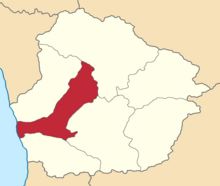The Senaki uezd[a] was a county (uezd) of the Kutaisi Governorate of the Caucasus Viceroyalty of the Russian Empire. It bordered the Zugdidi uezd to the west, the Lechkhumi uezd to the north, the Kutaisi uezd to the east, and the Ozurgeti uezd to the south. The area of the uezd corresponded to most of the contemporary Samegrelo-Zemo Svaneti region of Georgia. The Senaki uezd was eponymously named for its administrative center, Senaki.[1]
Senaki uezd
Сенакскій уѣздъ | |
|---|---|
 Location in the Kutais Governorate | |
| Country | Russian Empire |
| Viceroyalty | Caucasus |
| Governorate | Kutaisi |
| Established | 1867 |
| Abolished | 1930 |
| Capital | Senaki |
| Area | |
| • Total | 2,127.27 km2 (821.34 sq mi) |
| Population (1916) | |
| • Total | 159,678 |
| • Density | 75/km2 (190/sq mi) |
| • Urban | 11.73% |
| • Rural | 88.27% |
History edit
The Senaki uezd was formed in 1846 as part of the Kutaisi Governorate on the territory of the historical region of Samegrelo during the time of the Russian Empire. In 1918, the Kutaisi Governorate including the Senaki uezd was incorporated into part of the Democratic Republic of Georgia.[1]
Administrative divisions edit
The subcounties (uchastoks) of the Senaki uezd in 1913 were as follows:[2]
| Name | 1912 population |
|---|---|
| Abashskiy uchastok (Абашскій участокъ) | 20,740 |
| Bandzinskiy uchastok (Бандзинскій участокъ) | 15,246 |
| Martvilskiy uchastok (Мартвильскій участокъ) | 20,218 |
| Senakskiy uchastok (Сенакскій участокъ) | 7,587 |
Demographics edit
Russian Empire Census edit
According to the Russian Empire Census, the Senaki uezd had a population of 115,785 on 28 January [O.S. 15 January] 1897, including 58,585 men and 57,200 women. The majority of the population indicated Mingrelian to be their mother tongue, with a significant Georgian speaking minority.[3]
| Language | Native speakers | % |
|---|---|---|
| Mingrelian | 96,851 | 83.65 |
| Georgian | 14,338 | 12.38 |
| Russian | 1,395 | 1.20 |
| Imeretian | 895 | 0.77 |
| Armenian | 448 | 0.39 |
| Jewish | 448 | 0.39 |
| Greek | 401 | 0.35 |
| Polish | 175 | 0.15 |
| Turkish | 173 | 0.15 |
| Ukrainian | 124 | 0.11 |
| English | 85 | 0.07 |
| Lithuanian | 72 | 0.06 |
| German | 71 | 0.06 |
| Tatar[b] | 64 | 0.06 |
| Svan | 63 | 0.05 |
| Abkhaz | 24 | 0.02 |
| Romanian | 17 | 0.01 |
| Kurdish | 3 | 0.00 |
| Ossetian | 3 | 0.00 |
| Persian | 2 | 0.00 |
| Avar-Andean | 1 | 0.00 |
| Belarusian | 1 | 0.00 |
| Estonian | 1 | 0.00 |
| Other | 130 | 0.11 |
| TOTAL | 115,785 | 100.00 |
Kavkazskiy kalendar edit
According to the 1917 publication of Kavkazskiy kalendar, the Senaki uezd had a population of 159,678 on 14 January [O.S. 1 January] 1916, including 86,448 men and 73,230 women, 149,112 of whom were the permanent population, and 10,566 were temporary residents:[6]
| Nationality | Urban | Rural | TOTAL | |||
|---|---|---|---|---|---|---|
| Number | % | Number | % | Number | % | |
| Georgians | 12,441 | 66.42 | 139,303 | 98.83 | 151,744 | 95.03 |
| Russians | 2,836 | 15.14 | 4 | 0.00 | 2,840 | 1.78 |
| Jews | 847 | 4.52 | 1,639 | 1.16 | 2,486 | 1.56 |
| Armenians | 1,529 | 8.16 | 0 | 0.00 | 1,529 | 0.96 |
| Asiatic Christians | 769 | 4.11 | 0 | 0.00 | 769 | 0.48 |
| Other Europeans | 239 | 1.28 | 0 | 0.00 | 239 | 0.15 |
| Sunni Muslims[c] | 70 | 0.37 | 0 | 0.00 | 70 | 0.04 |
| North Caucasians | 0 | 0.00 | 1 | 0.00 | 1 | 0.00 |
| TOTAL | 18,731 | 100.00 | 140,947 | 100.00 | 159,678 | 100.00 |
Notes edit
- ^
- ^ Before 1918, Azerbaijanis were generally known as "Tatars". This term, employed by the Russians, referred to Turkic-speaking Muslims of the South Caucasus. After 1918, with the establishment of the Azerbaijan Democratic Republic and "especially during the Soviet era", the Tatar group identified itself as "Azerbaijani".[4][5]
- ^ Primarily Turco-Tatars.[7]
References edit
- ^ a b Tsutsiev 2014.
- ^ Кавказский календарь на 1913 год, pp. 160–167.
- ^ "Демоскоп Weekly - Приложение. Справочник статистических показателей". www.demoscope.ru. Retrieved 2022-06-27.
- ^ Bournoutian 2018, p. 35 (note 25).
- ^ Tsutsiev 2014, p. 50.
- ^ Кавказский календарь на 1917 год, pp. 198–205.
- ^ Hovannisian 1971, p. 67.
Bibliography edit
- Bournoutian, George A. (2018). Armenia and Imperial Decline: The Yerevan Province, 1900–1914. Milton Park, Abingdon, Oxon: Routledge. ISBN 978-1-351-06260-2. OCLC 1037283914.
- Hovannisian, Richard G. (1971). The Republic of Armenia: The First Year, 1918–1919. Vol. 1. Berkeley: University of California Press. ISBN 978-0520019843.
- Кавказский календарь на 1913 год [Caucasian calendar for 1913] (in Russian) (68th ed.). Tiflis: Tipografiya kantselyarii Ye.I.V. na Kavkaze, kazenny dom. 1913. Archived from the original on 19 April 2022.
- Кавказский календарь на 1917 год [Caucasian calendar for 1917] (in Russian) (72nd ed.). Tiflis: Tipografiya kantselyarii Ye.I.V. na Kavkaze, kazenny dom. 1917. Archived from the original on 4 November 2021.
- Tsutsiev, Arthur (2014). Atlas of the Ethno-Political History of the Caucasus (PDF). Translated by Nora Seligman Favorov. New Haven: Yale University Press. ISBN 9780300153088. Archived (PDF) from the original on 17 June 2023.
42°16′8″N 42°4′45″E / 42.26889°N 42.07917°E
